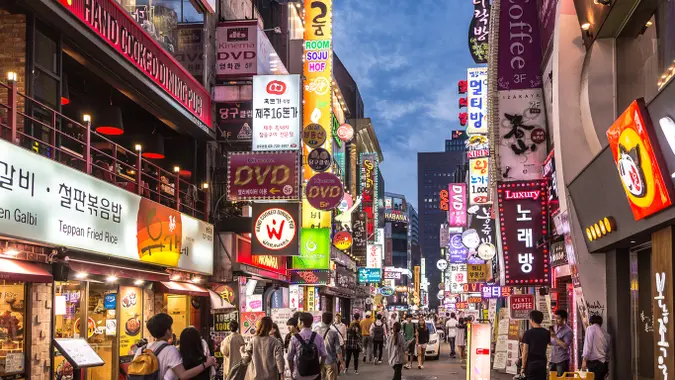How Much Money You Need To Be Considered Middle Class in These 8 Asian Countries

Commitment to Our Readers
GOBankingRates' editorial team is committed to bringing you unbiased reviews and information. We use data-driven methodologies to evaluate financial products and services - our reviews and ratings are not influenced by advertisers. You can read more about our editorial guidelines and our products and services review methodology.

20 Years
Helping You Live Richer

Reviewed
by Experts

Trusted by
Millions of Readers
Asia comprises 49 countries and territories, each with a distinct economic landscape. As the region undergoes rapid development, its expanding middle class is fueling consumer demand and economic growth.
According to the World Economic Forum, around 2 billion Asians belonged to the middle class in 2020, a number projected to rise to 3.5 billion by 2030. However, the definition of “middle class” varies significantly depending on factors such as cost of living, household size and local economic conditions.
Here’s a breakdown of how much income is required to be considered middle class across different Asian countries.
1. Vietnam
Vietnam’s expanding middle class is a key driver of the country’s impressive economic growth. This group, which typically earns between $6,000 and $18,000 annually, is diverse and dynamic, playing a crucial role in boosting consumer demand. In major cities like Hanoi and Ho Chi Minh City, where living costs are higher, a comfortable lifestyle usually requires an income at the upper end of this range.
2. India
India’s middle class is growing rapidly and is expected to reach 800 million people by 2030, becoming a major driver of economic growth and consumer spending. According to a 2024 survey, middle-class individuals earn between INR 500,000 and 3 million (about $6,000 to over $34,000) annually, contributing about 50% of the nation’s income. In cities like Mumbai, Delhi and Bangalore, a comfortable middle-class lifestyle often requires INR 600,000 to 2 million annually (nearly $7,000 to $23,000).
3. South Korea
As one of Asia’s most advanced economies, South Korea boasts a robust and sizable middle class, defined by higher income levels. Households earning between 2,000 and 5,000 won (national currency) per month, or 24,000 to 60,000 won annually, fall into this category. With continued urbanization, cities like Seoul, Busan and Incheon have become thriving economic hubs, where the middle-class benefits from a high standard of living and a strong consumer culture, playing a central role in driving the nation’s economic growth.
4. Philippines
The middle class in the Philippines is a key driver of economic growth, fueling consumer spending and development. Defined by annual incomes between $4,800 and $24,000, this group is expected to expand as government policies promote economic mobility, rising wages and urbanization. The Philippine middle class remains an increasingly influential force, shaping the country’s economic future.
5. China
China’s economic boom has significantly expanded its middle class, now one of the largest and most influential globally. The middle class is typically defined as earning $10 to $50 per day, or $3,600 to $18,250 annually. However, income disparities exist between urban and rural areas. In major cities like Beijing, Shanghai and Shenzhen, a comfortable middle-class lifestyle often requires a household income of ¥200,000 to ¥600,000 ($28,000 to $85,000) due to high costs of living.
6. Indonesia
Indonesia’s middle class is rapidly expanding, playing a key role in driving consumer demand and fueling the country’s economic growth. Middle-class income in Indonesia is generally defined as earning between IDR 60 million and IDR 360 million annually, approximately $3,900 to $23,400. However, the required income can vary by location. In cities like Jakarta, Surabaya and Bali, a comfortable middle-class lifestyle typically demands a household income of IDR 100 million to IDR 300 million annually, around $6,100 to $18,500.
7. Thailand
Thanks to a strong tourism sector, robust economy, industrial development and increasing urbanization, Thailand’s middle class has been growing steadily. The middle class in Thailand is generally defined as individuals earning between THB 200,000 and THB 1 million annually, or about $6,000 to $30,000. In cities like Bangkok, Chiang Mai and Pattaya, a comfortable lifestyle typically requires a household income of THB 300,000 to THB 800,000 annually, approximately about $9,000 to $24,000, due to higher living costs.
8. Japan
Japan’s middle class has long been the backbone of the nation’s consumer economy, playing a crucial role in driving domestic demand and maintaining overall economic stability. This group is defined by households earning between 30,000 and 80,000 yen annually. However, as the country faces economic pressures, its middle class is undergoing shifts, with an increasing number of people entering the ranks of the “working poor” and younger generations grappling with job insecurity.
 Written by
Written by  Edited by
Edited by 

























